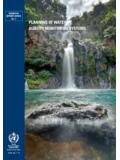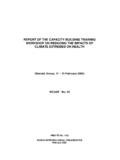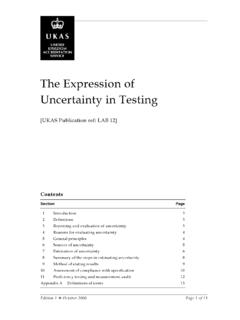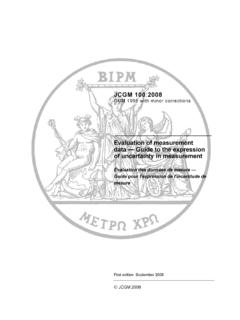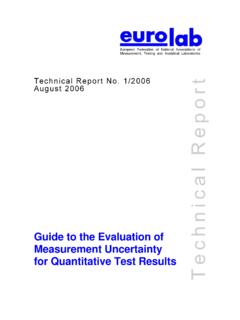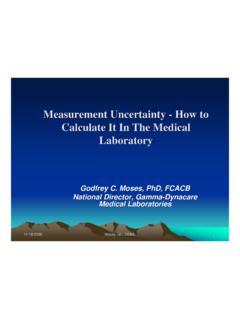Transcription of Aliteraturereview ofmethodsforestimatingtheuncertainty ...
1 WMO initiative onAssessment of the Performance of Flow Measurement Instrumentsand TechniquesProject output 6 uncertainty analysis of discharge determination via various techniquesTask (a) Literature review of methods for estimating the uncertaintyA literature reviewof methods for estimating the uncertaintyassociated with stage-discharge relationsJ er ome Le CozCemagref, Hydrology-Hydraulics, Lyon, FranceDraft version of January 18, 20121 Contents1 Scope of this literature review32 Position of the uncertainty associated with stage-discharge relationsand derived Physical basis: hydraulic control and reference regime.. uncertainty in individual stage-discharge ratings.. 73 Methods for the expression of uncertainty in stage-discharge Hydraulic modelling and sensitivity analysis.. Regression and likelihood techniques.. Bayesian inference and MCMC simulation.. Stationarity analysis.. uncertainty in instantaneous discharge and derived quantities.
2 154 Conclusions1621 Scope of this literature reviewThe expression of the uncertainty associated to stream discharge measurements or esti-mates is of paramount importance in issues related to water resources, flood frequencyanalysis, flood control, flood and drought forecast, compensation discharge and water useconflicts. The most common and most simple method for monitoring streamflow at a hy-drometric station is to establish a stage-discharge relation (rating curve, ,Rantz,1982,Schmidt,2002) used to convert continuously recorded water level into discharge time situations where a simple stage-discharge relation cannot be established with acceptableerrors, more complex relations including additional parameters such as the water slope, thestage change rate, or an index flow velocity, may be developed. This literature review isrestricted to 1) documents focusing on the most widespread relation between stagehanddischargeQ; and 2) documents proposing methods for estimating the uncertainty associ-ated with the rating curve.
3 Works dealing with other discharge determination methodsor with methods only used for establishing the rating curve without uncertainty analysiswere not considered in this accuracy and stability of a rating curve depend on the hydraulic conditions prevail-ing at the site, on the knowledge of the physical processes linking water stage and dischargeat the site, and on the availability and uncertainty of individual ratings, a set of directstage-discharge observations. The methodology for assessing the uncertainty associatedwith a given stage-discharge relation, over a given period of time and for given hydraulicconditions, still appears to be an open scientific issue. Along with a quick reminder of theposition of the problem, the following sections intend to provide a summary of relevantworks reported in the literature. As a conclusion, general requirements for an ideal andwidely accepted methodology are Position of the uncertainty associated with stage-discharge relations andderived quantitiesFirst of all, the difference between uncertainty in the stage-discharge relation (in referencehydraulic conditions) and uncertainty in the derived instantaneous dischargeQt(in theactual hydraulic conditions at timet) must be acknowledged.
4 Following the first-orderapproximation proposed by the ISO GUM, and assuming independent error sources, thecombined uncertainty inQtmay be written as follows:u2(Qt) =u2RC(Q) +u2HC(Qt) +( Q h)2u2(ht)(1) (Q) is the uncertainty in the stage-discharge relation established for reference(or usual) hydraulic conditions. Related errors mainly arise from improper mod-elling/knowledge of the hydraulic relation, typically theshape of the assumed func-tions and the calibration of the parameters. Even implicitly, a model of the hydraulicrelation is always assumed and must be justified is particularly im-portant in regions of the curve where individual ratings or other hydraulic data arescarce or missing, in the extrapolated parts of the stage-discharge relation forhigh flows, or towards the cease-to-flow (Q) may become detrimental inthese extrapolated regions of the rating (Qt) is the uncertainty related to errors due to real hydraulic conditions at timet, potentially differing from the reference flow regime.
5 Sources of errors includetransient flow effects (hysteresis) and variable hydraulic controls (backwater effectsin non-uniform flows, seasonal vegetation changes, changesin reach or control sectiongeometry). (ht) is the uncertainty in instantaneous water level measurementhtat timet. Ac-cording to the first-order approximation made here, it propagates proportionally tothe sensitivity coefficient of the stage-discharge relation Q/ , hydrologists often want to compute the uncertainty in the quantities derivedfrom the hydrograph (instantaneous discharge time series)computed from the rating curveand the water level time series. Those quantities may be averaged hydrological data (meandischarges, volumes, etc.), hydrological statistics (flood quantiles), or other variables suchas the cost of flood damages or the results of hydraulic modelsusing the discharge as Physical basis: hydraulic control and reference regimeA simple rating curve is a one-to-one relation between waterstage and discharge assumedto prevail at a cross-section of the flow in the reference hydraulic conditions.
6 This referencehydraulic regime is seldom explicitly defined. Nevertheless, any time the flow deviates fromthe reference regime, significant errors in the discharge estimate may appear. Such errorsmust be distinguished from the errors directly related to the reference stage-dischargerelation. Most often, the reference regime refers to the mean hydraulic conditions usuallyprevailing in the considered flow [Schmidt,2002], steady flow (no transient effects) andusual hydraulic controls ( no varying backwater effects, no change in channel roughnessor the geometry of the controlling cross-section). When thereference regime is permanentlychanged, , in case of changed channel geometry after a flood, the rating curve is nolonger valid, and a new one must be established corresponding to the new reference changes of the reference regime, , in case of seasonal vegetation growth orvariable downstream boundary condition, may impose the useof different rating curvesaccording to time physical characteristics of the channel which govern the link between stagehanddischargeQat a section constitute the hydraulic control.
7 Basically, two kinds of hydrauliccontrols may be distinguished: channel versus section controls ( ). When channelcontrol occurs, the flow is mainly regulated by the geometry and roughness of a certainextent of the channel. In non-uniform flow cases, the downstream boundary conditionmay also influence the stage-discharge relation (backwatereffects). When section controloccurs, the flow is mainly regulated by the geometry and surface state of a cross-sectionor hydraulic work where the flow becomes critical due to a water fall ( riffle, weir, sill)5or due to constriction ( , Venturi, Parshall flumes). Since this control cross-section islocated in the downstream vicinity of the stage measurementpoint, head losses related tothe flow approach conditions are accounted for with a discharge 1:Channel (a) versus section (b) hydraulic control along an idealized channel hydraulic control according to discharge range (c), in a compound channel cross-sectionwith a flood evacuation controls might change the role they play commensurate with the stage inthe river, , active for low flows, negligible for high flows.
8 Shows the example ofa compound channel cross-section where flood flows are controlled not only by the mainchannel, but also by the floodplain and a flood evacuation orifice. In this case, channeland section controls are activated hydraulic formulas for uniform flows (Ch ezy, Manning-Strickler) and for usualhydraulic works (weirs, gauging flumes.. ) can be approximated by simple power functionsof the following general expression :Q= (h h0)n(2)where is a coefficient,h0is a cease-to-flow reference level, andnis an exponent withtypical theoretical values 5/3 (Manning-Strickler), 3/2 (rectangular weir), 5/2 (triangularweir).As soon as hydraulic controls are identified and some hydraulic data are gathered,it is therefore possible to model most stage-discharge relations using sums or piecewisecombinations of power functions like , suited for different segments of the stage-discharge relation. Of course, numerical hydraulic modelscan be built and calibrated tocompute the stage-discharge relation.
9 SinceQandhare regarded as cross-section averagedparameters, a one-dimensional model can be used, as well as more sophisticated the complexity of the model, the quality of the results will be poor if the relevanthydraulic controls are not taken into account uncertainty in individual stage-discharge ratingsStage-discharge ratings conducted by hydrometry staff consist of direct measurements ofstage and discharge over a reduced period of time, in given hydraulic conditions. It shouldbe noted that most authors recognize that uncertainty in stage measurements of individualratings are negligible compared with uncertainty in discharge measurements. It could alsobe argued that an individual rating is an estimation of discharge knowing a given , all the uncertainty of the rating can be expressed in the discharge least three kinds of errors should be considered when suchmeasurements are to beused for establishing or evaluating a stage-discharge relation:1.
10 Errors related to the measurement process itself, combining instrumental errors, en-vironmental errors, human errors, and spatial integrationerrors2. time integration error due to flow non-stationarity during the measurement3. systematic error due to hydraulic conditions deviating from the reference flow regimeThe literature provides some methods for quantifying discharge uncertainty accordingto the measurement technique ( for current-metersHerschy,2002,Pelletier,198 8).However, the task remains challenging for many practitioners facing a range of situationsand techniques, and some research work is still ongoing in order to improve the uncertaintyanalysis of individual discharge measurements. It is remarkable that none of the worksreferenced in this review on rating curve uncertainty analysis was based on a thoroughuncertainty analysis of individual ratings. In many cases indeed, an arbitrary relativeuncertainty value was fixed for all discharge the flow significantly varies during the measurement process, time integrationerrore1may occur (cf.)


